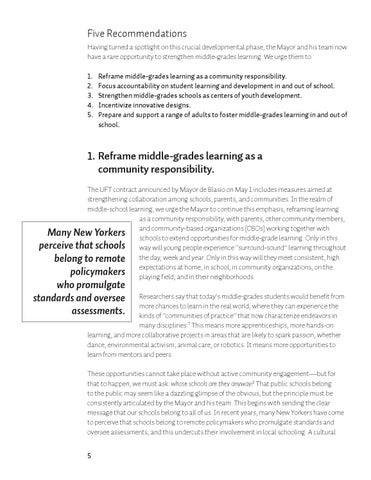Five Recommendations Having turned a spotlight on this crucial developmental phase, the Mayor and his team now have a rare opportunity to strengthen middle-grades learning. We urge them to: 1. 2. 3. 4. 5.
Reframe middle-grades learning as a community responsibility. Focus accountability on student learning and development in and out of school. Strengthen middle-grades schools as centers of youth development. Incentivize innovative designs. Prepare and support a range of adults to foster middle-grades learning in and out of school.
1. Reframe middle-grades learning as a community responsibility. The UFT contract announced by Mayor de Blasio on May 1 includes measures aimed at strengthening collaboration among schools, parents, and communities. In the realm of middle-school learning, we urge the Mayor to continue this emphasis, reframing learning as a community responsibility, with parents, other community members, community-based organizations (CBOs) working together with Many New Yorkers and schools to extend opportunities for middle-grade learning. Only in this perceive that schools way will young people experience “surround-sound” learning throughout belong to remote the day, week and year. Only in this way will they meet consistent, high at home, in school, in community organizations, on the policymakers expectations playing field, and in their neighborhoods.
who promulgate standards and oversee assessments.
Researchers say that today’s middle-grades students would benefit from more chances to learn in the real world, where they can experience the kinds of “communities of practice” that now characterize endeavors in many disciplines.7 This means more apprenticeships, more hands-on learning, and more collaborative projects in areas that are likely to spark passion, whether dance, environmental activism, animal care, or robotics. It means more opportunities to learn from mentors and peers. These opportunities cannot take place without active community engagement—but for that to happen, we must ask: whose schools are they anyway? That public schools belong to the public may seem like a dazzling glimpse of the obvious, but the principle must be consistently articulated by the Mayor and his team. This begins with sending the clear message that our schools belong to all of us. In recent years, many New Yorkers have come to perceive that schools belong to remote policymakers who promulgate standards and oversee assessments, and this undercuts their involvement in local schooling. A cultural 5
